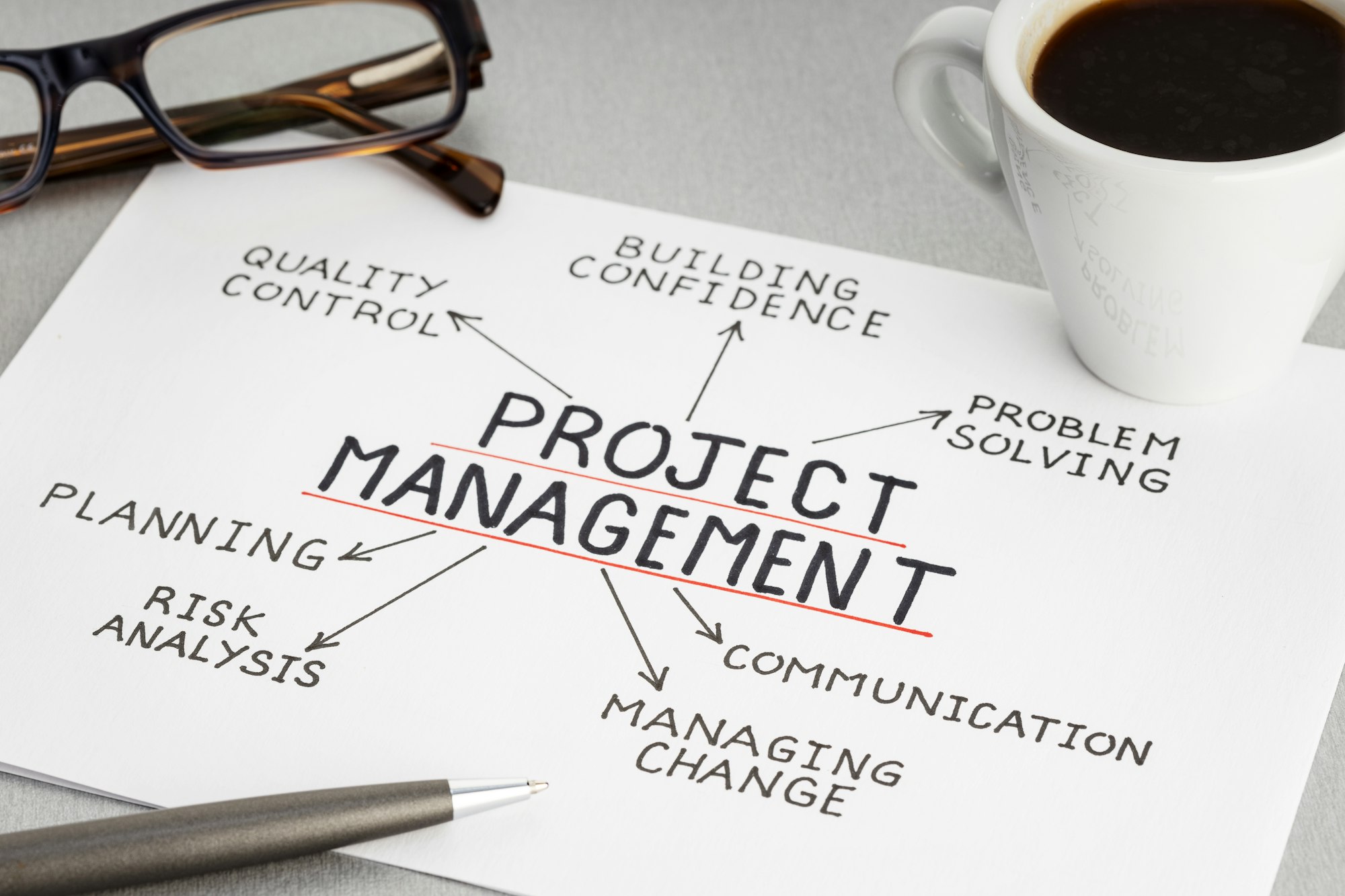
Accurate project cost estimation is a critical component for the success of any project. If you’ve ever been caught off guard by unexpected expenses, you know how crucial it is to pin down the financial details from the get-go.
But what exactly goes into crafting a reliable cost estimate? Understanding the key factors can help you steer clear of budget overruns and ensure that your project remains on track financially.
“Success in project management relies heavily on precise cost estimation. Missing the mark here can lead to delays, resource wastage, and unmet objectives.”
In this article, we’ll delve into the essential factors that influence project cost estimates. From scope definition to risk management, we’ll cover everything you need to know to create a budget that stands up to real-world challenges. Let’s dive in and explore what can make or break your project’s financial plan.

Several key players contribute to crafting precise project cost estimates. Understanding their roles and responsibilities can help ensure a project’s budget aligns with its financial goals.
Project Managers: As the primary overseer of the project, you need to liaise with various stakeholders and gather comprehensive input. This enables the formulation of a realistic budget.
Financial Analysts: These experts analyze financial data, forecast costs, and ensure all budget calculations are grounded in solid financial principles.
Team Leads: You’re crucial for providing insights on resource requirements, task durations, and labor needs. Accurate data from you translates directly into more reliable cost estimates.
Procurement Specialists: By interacting with vendors and understanding market trends, you can provide up-to-date pricing information, which is pivotal for estimating material and service costs accurately.
Clients: Clear communication with clients helps in defining project scope and understanding expectations, which are essential for avoiding scope creep that can inflate costs unexpectedly.
By fostering collaboration among these actors, you can navigate the complexities of project budgeting with greater ease and accuracy.

Creating a precise project budget might seem daunting, but it doesn’t have to be. Here are some practical tips to refine your cost estimates:
Remember, a well-drafted budget lays the foundation for project success. By applying these tips, you’re not just estimating costs, but you’re also paving the way for efficient resource management and effective planning.
A well-defined scope lays the foundation for accurate project budgeting. Think of it as setting the boundaries of your project—the clearer these boundaries are, the easier it becomes to estimate the resources required.

When the project scope is vague or constantly changing, it’s almost impossible to provide a solid cost estimate. Detailed scope documentation includes project objectives, deliverables, tasks, and constraints, thereby minimizing the risk of budget overruns.
To define the scope accurately, involve all stakeholders from the beginning. This ensures that everyone has the same understanding of project goals and deliverables. For example, a detailed Work Breakdown Structure (WBS) can break down tasks into manageable sections, making it easier to allocate costs and resources accurately.
Additionally, scope definition should consider possible risks and how they might impact the budget. Including risk management strategies in the scope documentation can safeguard your project against unforeseen financial burdens.
One effective method to guarantee clear scope definition is regularly reviewing and updating the scope documentation throughout the project lifecycle.
This not only maintains alignment among team members but also ensures budget estimates remain relevant. As changes occur—or new stakeholder requirements arise—updating the scope helps maintain budget accuracy without causing scope creep.
In summary, meticulous scope definition is crucial for setting realistic budgets. By establishing clear boundaries and involving stakeholders, you ensure cost estimates are as accurate as possible.
Regular updates and risk management further enhance your ability to stay within budget, ultimately leading to project success.
Improving the accuracy of your project cost estimates can significantly impact project success. Here are some actionable steps to enhance your estimation process:
1. Leverage Historical Data:
Analyzing data from previous projects can provide valuable insights. Look back at past projects that were similar in scope and complexity to identify patterns and learn from any estimation errors.
2. Use Advanced Estimation Tools:
Modern project management software, like Wrike, includes features designed to streamline cost estimating and track assumptions. By using these tools, you can compare your estimates to actual costs in real-time, allowing you to make adjustments on the fly.
3. Adopt a Parametric Estimating Approach:
Parametric estimating involves using statistical relationships between historical data and other variables to predict future costs. For greater accuracy, ensure that all component factors and determinants are precise and up-to-date.
4. Break Down the Project Scope:
A well-defined project scope can prevent cost overruns. Divide the project into smaller, more manageable sections and estimate the cost of each section individually. This way, you can catch potential issues early and make adjustments before they escalate.

5. Factor in Variables and Risks:
Recognize that variables and unexpected circumstances can affect project costs. Include potential risk factors in your estimates and provide contingency plans. This way, you’re prepared for any surprises that might come up.
6. Involve Subject Matter Experts:
Consulting with experts who have specific knowledge related to certain parts of the project can improve estimate accuracy. Their insights can uncover overlooked details or provide a more realistic view of project requirements.
7. Regularly Update Estimates:
Cost estimation is not a one-time task. As the project progresses, continuously revisit and update your estimates. Regular monitoring helps ensure your budget remains on track, reflecting any changes in project scope or unforeseen costs.
Clear and open communication is vital for maintaining budget transparency throughout the lifecycle of any project. When everyone on the team understands the financial landscape, it creates a sense of ownership and accountability.
To achieve this, you should encourage regular updates and discussions about the project’s budget status.
Utilizing Collaborative Tools
One effective way to facilitate this communication is by using project management software, such as Wrike. These platforms offer features that support collaborative budgeting efforts, such as dashboards for tracking costs, time, and tasks.
Your team can easily share updates, flag potential issues, and keep the budget aligned with actual spending. This shared visibility helps to ensure everyone is on the same page and can act promptly if adjustments are needed.
Another critical strategy is to hold regular financial check-ins. These meetings should be a forum where stakeholders can review the budget, compare estimates versus actuals, and discuss any variances.
Regularly scheduled financial reviews ensure that small issues are caught early before they become significant problems.
Lastly, maintaining transparency with external stakeholders, such as clients or sponsors, is equally essential. Keeping them informed through detailed progress reports that include financial snapshots helps to build trust and manage expectations.
Transparency fosters a collaborative environment where stakeholders feel involved and informed, contributing to smoother project execution.
In summary, prioritizing effective communication by leveraging the right tools, holding regular financial check-ins, and maintaining openness with all stakeholders can significantly enhance budget transparency and help keep your project on track.

When it comes to keeping your project budget on track, regular monitoring and updating of cost estimates are vital. This ongoing process ensures that any potential deviations are identified and corrected promptly, helping you avoid unpleasant surprises down the road.
Consistently tracking your project’s financial health allows you to:
Regular updates to cost estimates account for changes in scope, unexpected expenses, and any other factors that might affect your budget.
Here are some tips to maintain accuracy in your project cost estimates:
By incorporating these practices into your project management routine, you can better monitor and keep your project’s budget aligned with its goals, ensuring a smoother and more predictable delivery.
Unexpected costs can throw even the most meticulously planned projects off balance. However, there are ways you can handle these surprises without completely derailing your project. Here are a few strategies:
One of the best ways to prepare for unexpected costs is to have a contingency fund. This is a reserved portion of your budget that you set aside for unforeseen expenses.
Typically, a contingency fund should range from 5% to 10% of your overall budget. Having this cushion can provide much-needed financial flexibility.
Risk management is not a one-time activity. Regularly updating your risk management plan allows you to anticipate potential issues before they become costly problems.
Take the time to review risks at every project milestone and adjust your plans accordingly. This proactive approach can save you time and money in the long run.
When unexpected costs arise, it’s crucial to reassess your project’s expenses. Categorize all costs into essential and non-essential.
This will help you determine where you can cut back or delay spending, ensuring that the project can still progress without sacrificing its core objectives.
Clear and transparent communication with stakeholders is key when dealing with unexpected costs. Make sure that everyone involved in the project is aware of the financial situation and the steps being taken to address it.
This transparency can prevent misunderstandings and foster a collaborative approach to problem-solving.

Sometimes, the best way to handle extra costs is to go back to the drawing board. Reevaluate the project scope to determine if there are any elements that can be scaled back or removed.
Adjusting your scope can often free up resources that can be redirected to cover unexpected expenses.
By planning for unexpected expenses and responding swiftly when they arise, you can help ensure that your project remains on track and on budget. Preparedness and flexibility are your best tools in managing the unexpected.
Historical data profoundly impacts project cost estimates by providing a reliable foundation for predictions. When past project data is available and of good quality, it enables project managers to draw parallels and make more accurate forecasts.
This information helps in identifying trends, patterns, and anomalies, thereby making the estimation process more robust and defensible. Ultimately, leveraging historical data leads to more precise and dependable cost estimates.
Scope changes can significantly disrupt project cost estimates. Any alteration in project scope—be it adding new features, extending timelines, or modifying deliverables—requires reevaluation of resources and budget.
These changes often lead to increased costs due to additional labor, extended timelines, and potential rework. Hence, it’s vital to manage scope changes meticulously to maintain budget accuracy.
Team expertise plays a crucial role in project budgeting accuracy. A skilled and experienced team can more effectively forecast needs, foresee potential challenges, and implement efficient solutions.
They bring valuable insights and knowledge that improve the reliability of cost estimates. Conversely, a less experienced team might overlook critical aspects, leading to underestimation or overestimation of costs.
Effective stakeholder communication is key to enhancing cost estimation accuracy. Regular and transparent communication ensures that all parties are aligned regarding project expectations, changes, and resource requirements. This reduces misunderstandings and assumptions that could lead to inaccurate estimates. When stakeholders are kept informed, they can contribute valuable feedback and insights that help refine budget forecasts.

Market conditions can dramatically influence project cost estimates. Factors such as inflation, supply chain disruptions, or changes in commodity prices can lead to fluctuating costs.
Staying informed about current market trends and economic conditions helps project managers anticipate potential cost variations and adjust their estimates accordingly. This proactive approach minimizes the risk of significant budget overruns.
In conclusion, achieving accurate project cost estimates is a multifaceted process that hinges on a variety of crucial factors, including detailed scope definition, effective communication, and regular monitoring.
The use of collaborative tools and regular financial check-ins ensures that all stakeholders remain informed and engaged, promoting transparency throughout the project’s lifecycle.
Building a reliable contingency fund and keeping your risk management plan up to date helps in handling unexpected costs efficiently. Regularly prioritizing expenses and maintaining transparent communication lines further contribute to minimizing budget discrepancies.
Remember, reevaluating your project scope when necessary can help in aligning your cost estimates with the project’s actual needs.
Lastly, leveraging statistical and quantitative approaches, such as regression analysis and expert judgment, can significantly enhance the reliability of your cost estimates.
As you embark on your project journey, integrated planning, continuous collaboration, and vigilant updating will be your keys to financial success.



